Knickerbocker, Texas, Tom Green County. (original) (raw)

The Knickerbocker Ranch
Photo courtesy Hiram Joel Jacques
History in a Pecan Shell
The town was once second only to San Angelo in size and political influence in the county after Ben Ficklin was washed away in the great flood of the Concho River.
The name comes from two of the town's early settlers who were related to Washington Irving, the American writer who was at the peak of his popularity at that time.
Diedrich Knickerbocker was the fictitious narrator of Irving's History of New York.
In 1875 the three Baze brothers donated land for a church, school, and cemetery on the northwest side of Dove Creek. They installed an irrigation ditch to grow hay, and melons to sell to the Fort Concho soldiers.

Joseph Tweedy and wife
Photos circa 1881, courtesy Hiram Joel Jacques
In 1877 Joseph Tweedy, J. Barlow Reynolds and the Grinnell Brothers drove their herds of sheep from their camp near Brackettville.
They established the Knickerbocker ranch / store on the SE side of Dove Creek.
A post office was opened in 1881. In the 1880s the Tweedy Mercantile Company dealt in oats, wheat, and corn. Second only to the crops was sheep production.
After a collapse in wool prices, the original settlers left, leaving only J.Tweedy. He platted a townsite on his land, and set up his own irrigation company for farms along Dove Creek.
Stephen Dexter Arthur planted cotton as an experiment in 1887 and produced Knickerbocker's first bale. The ruins of his water-driven gin can be seen near the bridge at Dove Creek. Arthur built a Methodist church on land donated by Joseph and Elizabeth Tweedy. In 1889 the town relocated to a site with better water.
The town had twenty-five residents in 1884, fifty in 1890 but by the late 1890s the population had swollen to 250.
During its boom times, Knickerbocker seemed to have two of everything. The town had two gins, two saloons, two blacksmiths, two hotels and two stores. It also had an undertaker - just one.
Kinckerbocker also had an early sanitarium since doctors all across the country were sending people to dryer climates. Later, nearby Carlsbad became a huge facility for tuberculosis patients.
Knickerbocker's adobe store / post office, built in 1896 remained standing until 1936. Knickerbocker got its first school, in 1889 and a school for Mexican children six years later.
A lawless element hung out near Knickerbocker and two members of this group staged a train robbery near Sanderson, Texas (see The Last Full-sized Train Robbery in Texas).
A brick school built in 1926, served until the school consolidations of the 1950s. In 1956 Knickerbocker merged with Christoval.
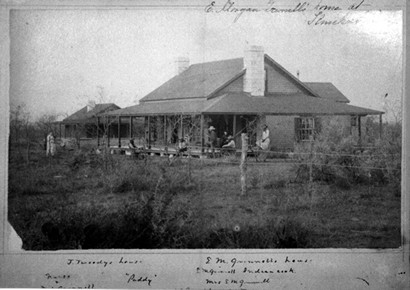
The E.M. Grinnell House
Photo courtesy Hiram Joel Jacques

Knickerbocker residents
Photo courtesy Fort Concho Museum
Pre-1912 group photo courtesy Ralph D. Ellis
Click on photo for large image
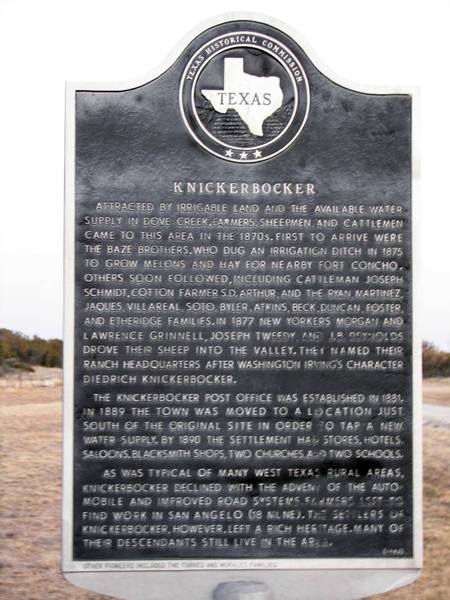
Knickerbocker Historical Marker
On FM 2335 in front of Knickerbocker Community Church
Photo courtesy Barclay Gibson, December 2006
Historical Marker
Knickerbocker
Attracted by irrigable land and the available water supply in Dove Creek, farmers, sheepmen, and cattlemen came to this area in the 1870s. First to arrive were the Baze brothers, who dug an irrigation ditch in 1875 to grow melons and hay for nearby Fort Concho. Others soon followed, including cattleman Joseph Schmidt, cotton farmer S. D. Arthur, and the Ryan, Martinez, Jaques, Villareal, Soto, Byler, Atkins, Beck, Duncan, Foster, and Etheridge families. In 1877 New Yorkers Morgan and Lawrence Grinnell, Joseph Tweedy, and J. B. Reynolds drove their sheep into the valley. They named their ranch headquarters after Washington Irving's character Diedrich Knickerbocker.
The Knickerbocker Post Office was established in 1881. In 1889 the town was moved to a location just south of the original site in order to tap a new water supply. By 1890 the settlement had stores, hotels, saloons, blacksmith shops, two churches, and two schools.
As was typical of many West Texas rural areas, Knickerbocker declined with the advent of the automobile and improved road systems. Farmers left to find work in San Angelo (18 mi. NE). The settlers of Knickerbocker, however, left a rich heritage. Many of their descendants still live in the area.
(1983)
Knickerbocker, Texas Landmarks
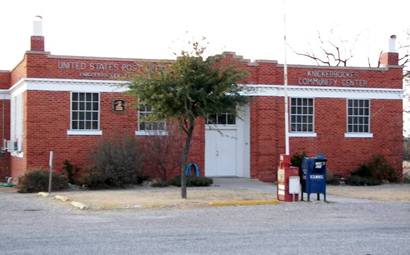
Knickerbocker Post Office and Community Center
TX 76939
Photo courtesy Barclay Gibson, December 2006
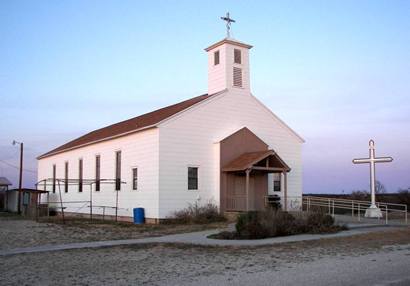
Immaculate Conception Catholic Church
Photo courtesy Barclay Gibson, December 2006
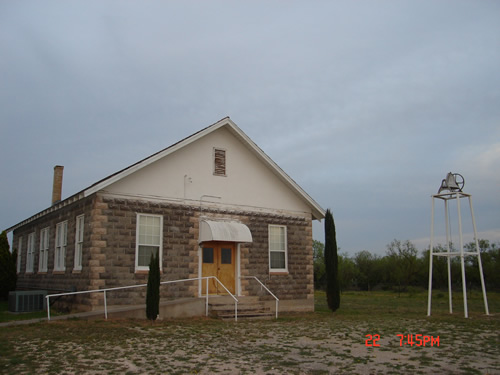
Knickerbocker Community Church
Photo courtesy Drew Sykes, April 2007
Mr. Hiram Joel Jacques' personal look at the people who settled this region in the 1880s:
"My late father's ancestors have deep roots in Ben Ficklin and Knickerbocker history and Tankersley.
My great-great-grandfather, Tomas Jaques de Salazar (1800-1880), moved to Ben Ficklin around 1871-72 with his family.
He was the oldest man in Fort Stockton in 1870 at the age of 70 years. He crossed over to Fort Stockton, Texas from Chihuahua by wagon in 1870. In 1872, Tomas and two of his four sons, Trinidad and Jesus Jose, signed the Petition of 1872 to form Tom Green County, which included about 13 of today's counties. Tomas died around 1880, two years before the great flood of 1882.
Around 1886, Two sons then moved toward El Paso and two settled in Knickerbocker. My great-grandfather, Honesimo Jaques, worked for Joseph Tweedy and built his rock house in Knickerbocker.
My grandfather, Selso, worked for R. F. Tankersley as a foreman on his cattle ranch. Selso married the niece of R. F. Tankersley's second wife, Conchita Maldonado. My late father, Francisco (Frank) Jacques, was born on the Tankersley ranch in 1917."
- Hiram Joel Jacques, San Jose, CA ,August 14, 2003
Our special thanks to Hiram Jacques of San Jose, California and the Fort Concho Museum for providing the photos illustrating the Knickerbocker, Tankersley, Ben Ficklin and Fort Stockton pages.
Knickerbocker, Texas Forum

"[Above] is the authorization for my mother to carry and deliver mail on the Star Route (between Tankersley and Knickerbocker Texas.) Though no date is shown, it was likely sometime shortly before 1979--the year my mother's mother (the previous postal carrier) passed away. My grandmother McCleery took me and/or my sister with her when she ran the Star Route. - Ralph D. Ellis, July 17, 2014
- Subject: Knickerbocker
My mother, my grandma and my great grandmother was raised in Knickerbocker. My mother told me lots of stories back from her childhood that were quite amazing even though they are no longer with you. I see that the town has came quite a ways from being a Ghost Town. Why not call it Little House on the prairies instead of Ghost Town. - Sophia, May 22, 2022 - Subject: Knickerbocker: Mail and... baseball?
When I and my sister were young, in the fifties and early sixties, our grandparents lived next to Tankersly school, and our grandmother delivered the mail along the route between Tankersley (where Mr. Boggs was Postmaster) and Knickerbocker (where Mrs. Byrd was Postmistress). We kids would accompany her on occasion, and it was high adventure!
Attached is a photo, taken pre-1912, in which my grandmother's sister-in-law appears. I'm not sure what the group represents, but I see two of the young men in what appear to be baseball uniforms. A large letter K appears on the uniforms (and I think on the caps). My guess is that the K stands for Knickerbocker.
Can you tell me the address of someone who might be able to confirm what would make an interesting side-light to Knickerbocker's history? Any help appreciated. My email address is: r.ellis.ix@gmail.com - Very sincerely, Ralph D. Ellis, January 30, 2014 - Subject: Ghost town: Tankersley VS Knickerbocker
Your, tethered to the ranch, ghost town-busting reporter here reporting for service again. Visited your wonderful site again to check on updates. Saw updated photos of the Knickerbockers churches, thanks. But I noticed you still have us in the �Ghost Town� category. I will try one more time to convince you that we are not dead! This time by comparison. Check out your listing for Tankersley. It�s only 6 miles north of Knickerbocker. You have Tankersley in the regular city category. Tankersley does not exist anymore! It has not been even a village for fifty years. There nothing there that has any civic relationship to the lonely one or two ranchers near by. [A] ranch office is there but that�s it. There�s a State owned sign that says �Tankersley� but I or anyone else would be hard pressed to point out where the town is.
Tankersley is a Ghost town not Knickerbocker!
Again, Knickerbocker has a community center, a post office, two churches, a Volunteer Fire Department, warm homes with warm bodies inside them on either side of the highway and down our side streets. Kids are playing in yards, people gather to visit and exchange the latest juicy gossip at the post office. We have yearly church festivals and secular picnics. I think we could even produce a town mayor when he�s sober, our spiritual deacon and a village idiot or two.
So, I am on my knees, I beg you, I implore you to put Knickerbocker in the regular town category and out of the ghost town category. - Sincerely, Drew Sykes, Sec/Tres, Knickerbocker Community Center, Knickerbocker Ranch, August 06, 2007 - We may have ghosts - but they are all in the cemetery.
Subject: Knickerbocker Texas labeled a "Ghost Town"
You are wrong in claiming the village of Knickerbocker a �Ghost Town�. Yes we have lost much of our business and population over the years but we are still a community that takes great pride in our little village. About 50 people live in Knickerbocker. We have a Community Center that is used quite frequently by the local citizens and it also has the Post office in it. It is beautifully landscaped in front with native plants. Soon we will have the start of a pavilion in the back of the center. We have two churches and two cemeteries. Come to think about it we may have Ghosts in Knickerbocker but they are only in the cemeteries! So could you please change the title you have given Knickerbocker. We are not a Ghost Town. If you need any other information or pictures I would be happy to provide. Thank you, Drew Sykes, Sec/Tres. Knickerbocker Community Center/ Knickerbocker Ranch, October 18, 2006
Texas Escapes town #700
September, 2003 Feature town
Texas Escapes, in its purpose to preserve historic, endangered and vanishing Texas, asks that anyone wishing to share their local history, stories, landmarks and recent or vintage photos, please contact us.
